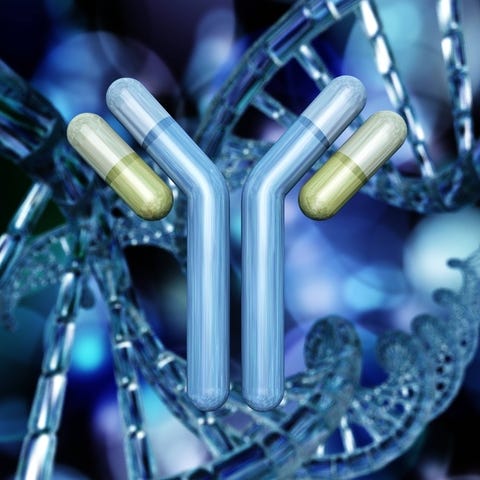Photo Credit: 131168508 | Antibody © Stanislav Rykunov | Dreamstime.com
I hope you have been enjoying this series on the immune system.
Nearly everyone talking or writing about health these days has something to say about “improving your immune system.” Learning a bit about its components will help you better understand how to support its various functions.
As I said previously, we were taught in medical school about the five types of antibodies (immunoglobulins) in the adaptive immune system. They are classified into IgG, IgM, IgA, IgD, and IgE. I learned them by memorizing the acronym G-A-M-E-D. They are distributed throughout the body, and each has a different function and concentration.
We’ve covered IgG, IgA, and IgE antibodies. In case you missed those articles, you can find them here and here and here. This week, we’ll touch on IgM and IgD antibodies to round out our review of the adaptive immune system.
IgM Antibodies
In humans, IgM is a very large antibody. It is most often represented as a pentamer (having 5 arms) as a way to attack the invading pathogen or antigen. It is present in serum in relatively high concentrations (approx. 1.47 mg/ml), so it is ready to go at the first sign of infection. In fact, IgM is the first antibody to rise in early infections, which often distinguishes an acute infection from one that had been going on for a while or has been lingering for a long time (identified by the IgG antibody.)
There are two types of IgM antibodies: innate (natural IgM) and adaptive (induced IgM).
The natural IgM uses the following three mechanisms to defend against infections:
neutralization by directly binding to foreign proteins;
trapping pathogens by grouping or clumping them together; and/or
transporting the foreign proteins to lymphoid tissues for neutralization.
Natural IgM also reacts to non-protein antigens, such as phosphatidylcholine and glycans, on the surface of foreign cells so it can recognize a foreign. Due to its polyreactivity, natural IgM can recognize foreign antigens without ever having encountered them, making it the very first line of defense against invaders.
In contrast to natural IgM, adaptive IgM is the first antibody class produced in response to an invading pathogen. It is mostly produced by B-cells in the spleen and lymph nodes. It has long been thought that IgM only participated as an acute response to infections. However, new evidence is coming to light that says IgM plays a role in long-term immunity.
IgD antibodies
Discovered in 1965, immunoglobulin D (IgD) is a unique immunoglobulin with a serum concentration far below those of IgG, IgA, and IgM but often higher than that of IgE. Despite being studied extensively for more than four decades, a specific role for serum IgD has not been determined. More things seem to be determined about what IgD doesn’t do than what it has been found to do.
For example:
IgD does not cross the placenta.
IgD does not bind to normal white blood cells, lymphocytes, neutrophils, or monocytes.
IgD does not increase with an antigen challenge.
While IgD levels are sometimes elevated in thyroid disease, celiac disease, and diabetes, their function in those conditions is not known.
The level of IgD is not age-dependent.
The meaning of an abnormal (increased or decreased) concentration of serum IgD is not known.
There are no genetic markers for high, low, or normal levels of IgD.
IgD has been shown to be elevated in maternal sera at term, but the influence of labor and delivery is not known.
IgD antibody seemed to behave like IgM antibody at the early stage of infection, but the ramifications of that property are unknown.
IgD antibodies have been elevated in many diseases and types of allergies; However, no significant correlation was found between total serum IgD and IgE levels.
What we DO know about IgD is that serum IgD is considered an early marker of B-cell activation (the immune system has been turned on). IgD can help IgM, IgG, or IgA antibodies in their fight against pathogens. Finally, IgD is a potent inducer of tumor necrosis factor-alpha (TNF-α), a protein that is important for resistance to infection and cancers.
Summary
Well, there you have it, a four-part series /primer on the adaptive immune system. Hopefully, this simplified and clarified information about antibodies, why they are important, and what they do.
Next week, there will be an overview of the innate immune system and the body’s toll-like receptors (TLRs), something I’ve wanted to write about for a long time.
Do you have topics I haven’t covered here in the last two years (check the search!) you’d like me to investigate, explain, and write about? If so, please post in the comments.







Really enjoyed this series. If I’ve learned anything over the last 4 years, it’s that the more we know about our own health, the better prepared we are to resist the onslaught of Big Pharma, the CDC, the WHO, et al! Thank you for helping to educate us!
For those of you that have not seen photos of the white fibrous clots that embalmers have been seeing since the shots rolled out:
https://laurakasner.substack.com/p/embalmer-blood-clots
Dr. Sherri - thank you for interviewing Tom Haviland last year. We are desperately trying to find another whistleblower from a cath lab willing to speak publicly about what they are finding in the living. We had two - they both have stopped talking.